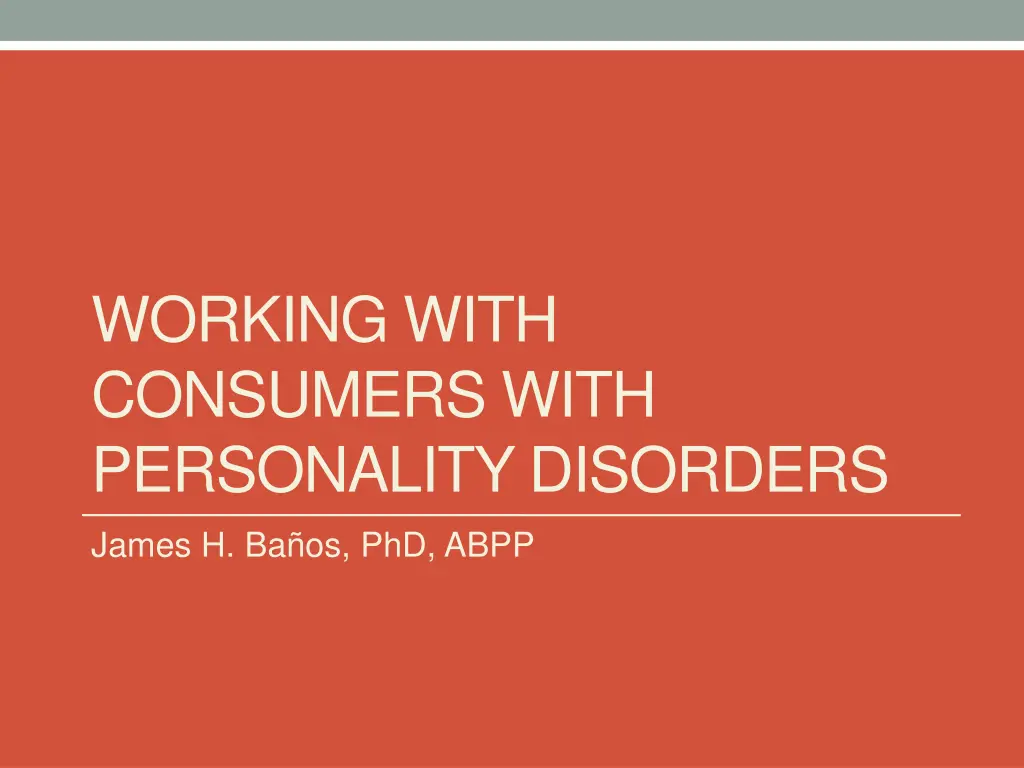
Understanding Personality Disorders: Insights from James H. Baños, PhD, ABPP
Gain valuable insights on working with consumers with personality disorders from the expertise of James H. Baños, PhD, ABPP. Learn where to start, diagnostic categories, and what constitutes a mental disorder. Explore the core features and development of personality disorders to enhance your understanding and support for individuals facing such challenges.
Download Presentation

Please find below an Image/Link to download the presentation.
The content on the website is provided AS IS for your information and personal use only. It may not be sold, licensed, or shared on other websites without obtaining consent from the author. If you encounter any issues during the download, it is possible that the publisher has removed the file from their server.
You are allowed to download the files provided on this website for personal or commercial use, subject to the condition that they are used lawfully. All files are the property of their respective owners.
The content on the website is provided AS IS for your information and personal use only. It may not be sold, licensed, or shared on other websites without obtaining consent from the author.
E N D
Presentation Transcript
WORKING WITH CONSUMERS WITH PERSONALITY DISORDERS James H. Ba os, PhD, ABPP
Where to Start? Personality Disorders Mental Health Difficult People
Where to Start? Diagnostic Categories Accommodations Thoughts on Working with Difficult Consumers
DIAGNOSTIC CATEGORIES
What constitutes a mental disorder? Clinically significant disturbance in: Emotional regulation Cognition Behavioral regulation Reflects dysfunction in psychological, biological, or developmental processes underlying mental function Usually associated with distress or disability in: Social functioning Occupational functioning Other important life activities
Diagnostic Categories What is a personality disorder? Enduring pattern of inner experience and behavior that deviates markedly from the expectations of the individual s culture. Manifested in two or more areas: Cognition (perceiving self, others, people, events, etc) Affect (range, intensity, stability, and appropriateness of emotional responses) Interpersonal functioning (instability of interpersonal relationships) Impulse control
Diagnostic Categories Core features: Distorted thinking patterns Problematic emotional responses Over- or under-regulated impulse control Interpersonal difficulties
Diagnostic Categories Development and Course Usually recognizable by adolescence Not usually diagnosed until after age 18 Relatively stable over time Some may become less evident with age
Diagnostic Categories Misconceptions All people with personality disorders are Difficult Toxic Disruptive Manipulative Adversarial Behavioral problems [insert unflattering adjective here] People with personality disorders cause distress in others more than they experience it themselves
Diagnostic Categories Very Difficult Difficult to work with Some interpersonal difficulties More distress to self than others
Diagnostic Categories Cluster A Cluster B Cluster C
Diagnostic Categories Cluster A Odd Eccentric Cluster B Dramatic, emotional, erratic Cluster C Anxious, fearful
Diagnostic Categories Cluster A Personality Disorders Paranoid Personality Disorder Distrust and suspiciousness of others Motives of others perceived as malevolent. Assume others are out to harm, take advantage, or humiliate them Pre-emptively attack other if they feel threatened Hold grudges, litigious, jealous Emotional life dominated by distrust and hostility
Diagnostic Categories Cluster A Personality Disorders Schizoid Personality Disorder Detachment from social relationships and expressions of emotion in interpersonal settings. Loners, prefer solitary activities Do not seem to enjoy or pursue social interactions Aloof, detached, cold Diminished social reciprocity
Diagnostic Categories Cluster A Personality Disorders Schizotypal Personality Disorder Social and interpersonal deficits Reduced capacity for close relationships Cognitive and perceptual distortions, eccentricities of behavior. Magical thinking, perceptual and cognitive distortions Odd and eccentric beliefs Maybe some genetic commonality with schizophrenia
Diagnostic Categories Cluster A Odd Eccentric Cluster B Dramatic, emotional, erratic Cluster C Anxious, fearful
Diagnostic Categories Cluster C Personality Disorders Avoidant Personality Disorder Social inhibition, feelings of inadequacy Hypersensitivity to negative evaluation Avoids activities involving interpersonal contact due to fears of criticism, disapproval, etc Unwilling to get involved in relationships unless sure of being liked
Diagnostic Categories Cluster C Personality Disorders Dependent Personality Disorder Excessive need to be taken care of that leads to submissive and clinging behavior and fear of separation Difficulty making decisions without excessive advice and reassurance Needs others to assume responsibility for most major areas of life Goes to excessive lengths to obtain nurturance and support Urgently seeks another relationship when one ends
Diagnostic Categories Cluster C Personality Disorders Obsessive-Compulsive Personality Disorder Preoccupation with orderliness, perfectionism, control, inflexibility, and adherence to the rules. Perfectionism that interferes with task completion Excessively devoted to work and productivity Overly conscientious, scrupulous Inflexible about matters of ethics, morality, values (not accounted for by religious or cultural beliefs) Rigidity and stubbornness
Diagnostic Categories Cluster A Odd Eccentric Cluster B Dramatic, emotional, erratic Cluster C Anxious, fearful
Diagnostic Categories Cluster B Personality Disorders Antisocial Personality Disorder Disregard for and violation of the rights of others Bullying and intimidating behaviors Deceit, theft, violations of rules of conduct Lacking in remorse Evidence conduct disorder in childhood
Diagnostic Categories Cluster B Personality Disorders Borderline Personality Disorder Instability of interpersonal relationships, self-image, and mood Intense fear of abandonment (real or perceived) Impulsive and self-destructive behaviors See the world in oversimplified polarized terms ( dichotomous thinking ) Inconsistent sense of self Poor emotional regulation
Diagnostic Categories Cluster B Personality Disorders Histrionic Personality Disorder Excessive emotionality and attention seeking Exaggerated and shallow emotional expression Melodramatic, overly emotional displays Emotions shallow, vague Perceive relationships as closer than they are Difficulty with truly meaningful relationships
Diagnostic Categories Cluster B Personality Disorders Narcissistic Personality Disorder Grandiosity, need for admiration, entitlement, lack of empathy Expansive sense of self-worth Arrogant, haughty Strong sense of entitlement Believe they are deserving of special treatment Need to be admired Lack of empathy for others Self-esteem may be very fragile
Context Accommodation Essential Functions And/or Conduct Standards Disorder, Diagnosis, Or Symptoms Functional Limitations
Personality Disorders FAQ: Are personality disorders considered to be disabilities under ADA? Answer: ADA does not provide a list of disorders that are considered disabilities Some exclusions (ex: individual engaged in substance abuse) General definition of disability (i.e., mental impairments that substantially limit one of more major life activities Some individuals with personality disorders would be considered to have a disability, others may not https://www.eeoc.gov/policy/docs/psych.html
Personality Disorders FAQ: May an employer discipline an employee with a disability for violating a conduct standard? Answer: Yes, if: The conduct rule is job-related and consistent with business necessity Other employees are held to the same standard https://www.eeoc.gov/facts/performance-conduct.html
Personality Disorders Functional Limitations Difficulty with emotional and affective regulation Problems with interpersonal boundaries Inconsistency in interpersonal interactions Problems with cooperation/teamwork Problems with tact Problems with dependability Judgment challenges Difficulty thinking logically (i.e., emotion-driven thinking) Dependence on others Distrust of others Problems with impulse control Low frustration tolerance Issues with proper dress/attire Difficulty with change Difficulty accepting supervision or feedback
Thinking about Accommodation General Categories of Approaches Creating a supportive work environment Removing or mitigating workplace stressors Adjusting the approach to supervision Flexibility/adaptability
Thinking about Accommodation Stress and Emotional Regulation Allow for use of appropriate stress management techniques Allow reasonable breaks to go somewhere comfortable to re- compose Allow for appropriate communication during work hours with doctor or other support person Use mentorship or supervision to help employee monitor behavior Focus on essential functions during times of stress Arrange back-up coverage when breaks are needed Flexible scheduling Modified break schedules Allowances to attend treatment Allow use of emotional support animal
Thinking about Accommodation Interpersonal Problems Minimize demands for working in team Alter positioning/location of workspace Use mentorship or supervision to help provide feedback Increase frequency or level of supervision Address the issue on a planned schedule during supervision Do not require (or appear to require) attendance at non- work social functions Allow employee to walk away from frustrating situations or confrontations (with follow-up)
Thinking about Accommodation Difficulty Accepting Supervision Schedule more frequent supervision focusing on smaller day-to-day issues before they escalate Provide day-to-day guidance and feedback Provide written job instructions or to-do lists by email Collaboratively establish written short and long-term goals Make use of team or group supervision Allow for job coaching Mentorship/coaching from someone other than supervisor
THOUGHTS ON WORKING WITH DIFFICULT CONSUMERS
Thoughts on working with difficult consumers Understand yourself Countertransference Know your baggage Is it them or you? Know your body language
Thoughts on working with difficult consumers In the moment Remain Calm - Respond don t react Don t give up or shut down avoid a defensive posture Watch your body language Shake it off
Thoughts on working with difficult consumers Challenging behaviors Self sabotage Don t do all the work Testing loyalty Splitting Boundaries and consistency Threats and complaints
Thoughts on working with difficult consumers Seek clarity and mutual understanding Listen Repeat Put things in writing Set clear benchmarks and expectations
Thoughts on working with difficult consumers Remember their humanity

